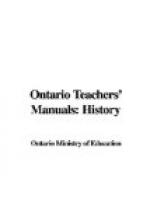SCOPE
The ideal course in history would include (1) a general view of the history of the world, giving the pupil knowledge enough to provide the proper setting for the history of his own country; (2) a more detailed knowledge of the whole history of his own country; (3) and a special knowledge of certain outstanding periods or tendencies in that history. In our schools, we should give most attention to the study of Canadian and British history as a whole, to enough of the history of France and other countries to make clear certain parts of our own history, and to certain important periods, such as the settlement of Upper Canada by the United Empire Loyalists, etc. (See Detailed Course of Study, p. 5.) We may also study our history along special lines of development—political, military, social, educational, religious, industrial, and commercial—but these phases are subjects of study rather for secondary schools and colleges.
STAGES OF STUDY
There are three stages in the study of history which, though they overlap each other, yet indicate different methods of treatment for pupils at different ages. They are the Story stage, the Information stage, and the Reflective stage. These stages are not exclusive, nor do they coincide with the first three Forms in the schools.
THE STORY STAGE
This stage is suitable for children in the primary grades and is chiefly preparatory to the real study of history in the higher grades. The need for this stage lies in the fact that the child’s “ideas are of the pictorial rather than of the abstract order”; yet his spontaneous interest in these things must be made to serve “as a stepping-stone to the acquired interests of civilized life.” The definite objects at this stage are:
(a) To create and foster a liking for historical study. It is impossible, in the public school life of a child, which is usually ended at the age of twelve to fourteen years, to accomplish all that has been indicated above concerning the aims of history teaching. The most that can be done is to lay the foundation and give the pupil a desire to continue his reading after his school days are over. Serious blame rests on the teacher whose methods of teaching history, instead of attracting the child to the subject, give him a distaste for it. If history is made real and living to children, it is usually not difficult to have them like it. (For suggestions, see p. 34.)




